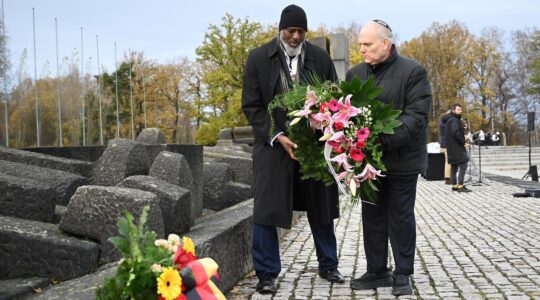Who will win the race to create a self-driving car?
If your immediate answer is Tesla, Google, or Uber, you would be justified, but very, very wrong. According to Navigant Research, a global market research firm on clean technology, the Ford Motor Company is currently the worldwide leader in the march to create the next wave of human transportation. If you are surprised to hear that a legacy company is currently outperforming the innovation sector in Silicon Valley, you are not alone. Yet understanding why Ford has been successful teaches a powerful lesson to Conservative Jews on the eve of the United Synagogue of Conservative Judaism (USCJ) convention, Dec. 1-5 in Atlanta.
In an interview with The New York Times Magazine, Ford CEO Jim Hackett argues that “in order to stay competitive, businesses often have to give up the things that made them great in the first place,” what he calls the “perversity law.” In a rapidly changing marketplace, legacy brands cannot succeed by trying to excel by the criteria of the previous marketplace, but by the next one.
Conservative Judaism is a legacy brand that thrived in the 20th-century through world-renowned scholarship, bustling suburban synagogues, high-quality educational brands, and a religious message that resonated with Jewish immigrants from Eastern Europe. While no one can claim to predict the future, Conservative Judaism cannot thrive by re-litigating the debates of the past, but by throwing caution to the wind and trusting that we can create a brighter future together.
Our convention challenges participants to dare together and leave with three key charges to empower every community to elevate Conservative Judaism’s brand:
- Experiment And Fail
Across North America, Conservative congregations experiment with new paradigms to embrace 21st century Judaism. In the past two years, Anshe Emet Synagogue in Chicago, Illinois created a promise to interfaith families that they place front-and-center on their website; Congregation Ohev Shalom in Wallingford, Pennsylvania engaged in an interfaith partnership called FUSE (Fellow of Urban Suburban Engagement) to create productive solutions to social justice problems on issues of race, economics, and religion; and Kehillath Israel in Brookline, Massachusetts downsized their physical space even though the congregation is growing in order to ensure that they focus on thickening community, rather than encouraging an edifice complex in the next generation.
All of these bold experiments by brick-and-mortar synagogues require risk-taking and a willingness to acknowledge that every experiment includes the slaying of sacred cows. If our communities are not willing to experiment and risk failure, they will never plant the seeds of a new renaissance.
- Think Like Founders, Not Like Managers
Why do communities like Ikar, Mechon Hadar, Nashuva, Svara, Romemu, etc. choose not to identify themselves as Conservative? I could offer one of many possible answers to that question, but to move forward, Conservative Jews must understand that this is the wrong the question to ask. The right question is “What can our leaders learn from the tremendous success of communities that overlap with us in core values, but diverge in institutional affiliation?”
Today, the energy in the Jewish community comes largely from startup organizations, and legacy organizations that want to succeed need to think like creators, rather than stewards. Our synagogues are great at maintenance, but not necessarily great at innovation. As my colleague Rabbi Gil Steinlauf and I work to help USCJ create an Innovation Lab for Conservative Judaism, the challenge is to help synagogues see their community for the first time, and imagine what would be possible if they did not feel beholden to the paradigms of the past.
- Trust What We Know
In March, the USCJ General Assembly of Kehillot overwhelmingly voted to allow non-Jewish partners to be full members of USCJ congregations. This decision was praised by most, and criticized by a few. Yet the story behind this decision is a profound reminder that the best expressions of Conservative Judaism will not emerge from thought pieces, but from the grassroots energy of the communities that practice an authentic and dynamic Judaism.
Conservative Judaism thrives when it creates third ways, new models to solving adaptive challenges whose solutions have not yet presented themselves. And time-after-time, the new ways that we express Conservative Judaism through social justice, inclusion, prayer, or outreach began as experiments in communities of all kinds and slowly became diffused throughout our network until they become the new standard of excellence. Some will praise the experiments, and others will criticize them, but the challenge of our network is to reject the culture of fear around what some people might say when we do what is right for Judaism and the Jewish people.
The Book of Proverbs says that, “the righteous are as bold as a lion” (28:1). No convention can solve every problem, yet the ambient noise of prognostication about Conservative Judaism obfuscates the most important thing leaders can do to make substantive change: action. We need to encourage leaders to not be afraid to take risks because they are worried about the past; we need leaders who trust that collectively we have the capacity to walk boldly into the emerging future.
Support the New York Jewish Week
Our nonprofit newsroom depends on readers like you. Make a donation now to support independent Jewish journalism in New York.
——–
Rabbi Joshua Rabin is the Director of Innovation at USCJ, and is the Program Director of the USCJ Convention. You can read more of his writings at www.joshuarabin.com.
The New York Jewish Week brings you the stories behind the headlines, keeping you connected to Jewish life in New York. Help sustain the reporting you trust by donating today.




